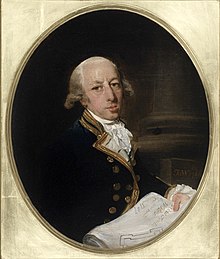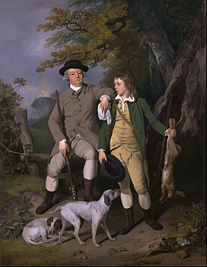Francis Wheatley (painter)


Francis Wheatley RA (1747 in London – 28 June 1801) was an English portrait and landscape painter.
Life and work[]

Wheatley was born at Wild Court, Covent Garden, London, the son of a master tailor. He studied at William Shipley's drawing school and the Royal Academy, and won several prizes from the Society of Arts. He assisted in the decoration of Vauxhall, and aided John Hamilton Mortimer in painting a ceiling for Lord Melbourne at Brocket Hall in Hertfordshire.[1]
In his youth, he lived a dissipated life.[1] He first exhibited at the Royal Academy in 1778, built up a good practice and was praised by the critics.[citation needed] But he fell in with extravagant company and was forced to flee his creditors: so he eloped to Ireland with Elizabeth Gresse, wife of a fellow artist John Alexander Gresse (1741–1794).[1]
In the summer of 1779 he was in Dublin with Elizabeth, whom he passed off as his wife, and established himself there as a portrait-painter, executing, among other works, the best-known interior of the Irish House of Commons.[1] He also painted the review of the Dublin regiments of the Irish Volunteers in College Green in November 1779, the basis for a best-selling print bought by numerous Irish Patriot supporters. He was careful to include the grandees of Dublin and also exotic visitors such as Princess Dashkov.
The circumstances of his private life were revealed, and he returned to London. He produced small landscapes, portraits, or street scenes, and began to work in imitation of the French painter Jean-Baptiste Greuze.[citation needed] His scene from the Gordon Riots of 1780 was engraved by James Heath; this was noted as one of his best, but was lost to a fire. He painted several subjects for Boydell's Shakespeare Gallery, designed illustrations to Bell's edition of the poets, and practised to some small extent as an etcher and mezzotint-engraver. It is, however, as a painter, in both oil and water-color, of landscapes and rustic subjects that Wheatley is best remembered. He was elected an associate of the Royal Academy in 1790, and an academician in the following year.[1]
In 1787 he married one of his most popular models, the young Clara Maria Leigh (1768–1838), who was also an artist. They had a daughter, also Clara Maria, born in 1788. After Wheatley died, his widow married the Irish actor Alexander Pope, and as Mrs Pope she was known as a painter of flowers and portraits.[2]
Selected gallery[]

The Salmon Leap, Leixlip

Portrait of a Sportsman with His Son

Captain Stevens

Duke of Newcastle seated on his horse next to his friend Colonel Litchfield, along with his gamekeeper, Mansell, and four Clumber Spaniels.

A Gentleman and his Dog in a Landscape

Helena and Count Bertram before the King of France
References[]
- ^ Jump up to: a b c d e One or more of the preceding sentences incorporates text from a publication now in the public domain: Chisholm, Hugh, ed. (1911). "Wheatley, Francis". Encyclopædia Britannica. 28 (11th ed.). Cambridge University Press. p. 583.
- ^ Mary Webster (2004). "Pope, Clara Maria (bap. 1767, d. 1838)". Oxford Dictionary of National Biography (online ed.). Oxford University Press. doi:10.1093/ref:odnb/22529. (Subscription or UK public library membership required.)
External links[]
| Wikisource has the text of the 1885–1900 Dictionary of National Biography's article about Wheatley, Francis. |
| Wikimedia Commons has media related to Francis Wheatley. |
- 49 artworks by or after Francis Wheatley at the Art UK site
- Webb, Alfred (1878). . A Compendium of Irish Biography. Dublin: M. H. Gill & son.
- Francis Wheatley online (ArtCyclopedia)
- Francis Wheatley (Yale Center for British Art)
- Wheatley's paintings of Shakespeare scenes (Emory University, English department)
- A market scene (Oil on canvas - Sphinx Fine Arts)
- Parlington Hall was the home for the Irish House of Commons until 1905 Now at Lotherton Hall
- 1747 births
- 1801 deaths
- English landscape painters
- English watercolourists
- English portrait painters
- Royal Academicians
- People from Covent Garden
- Painters from London






